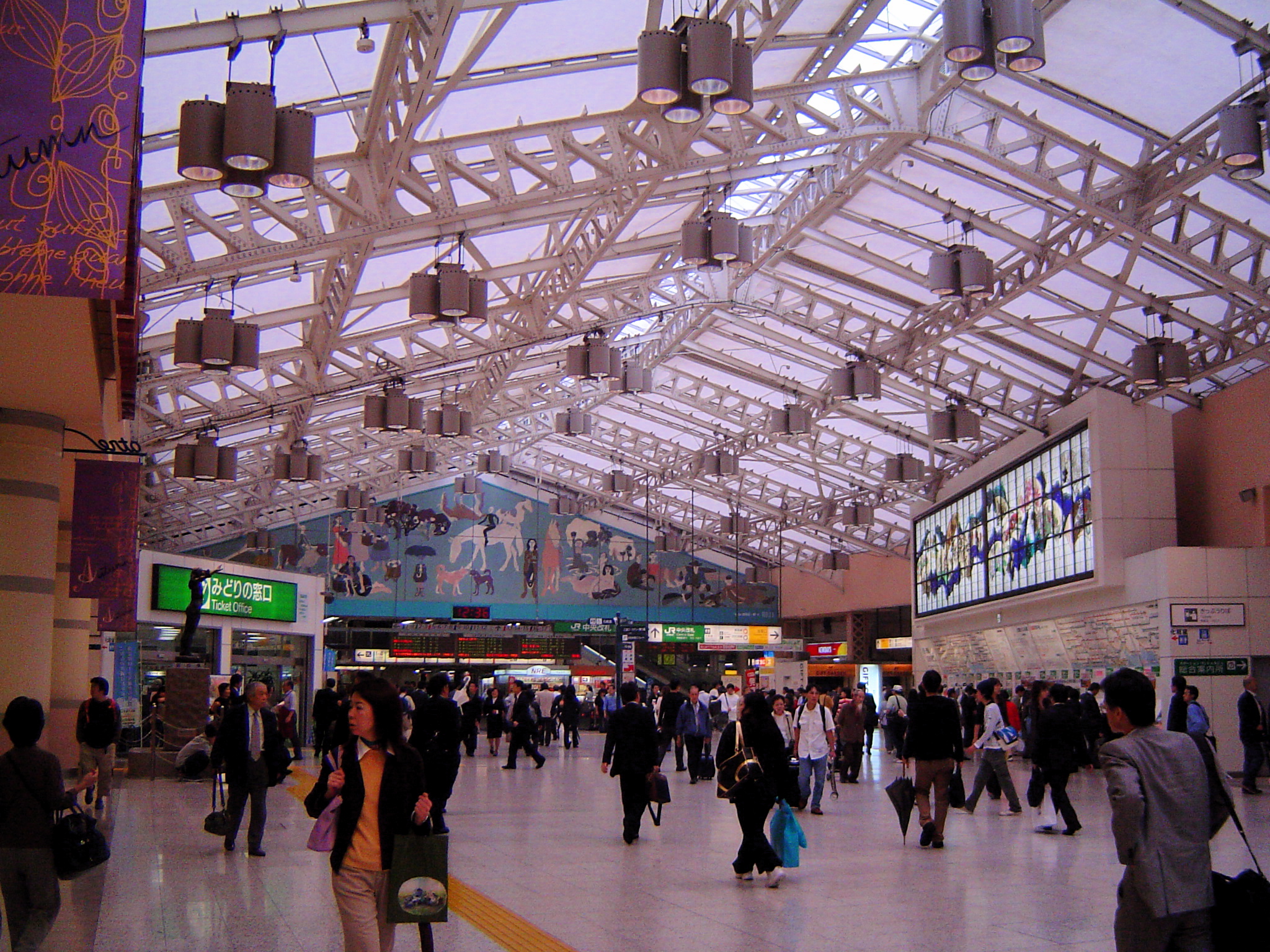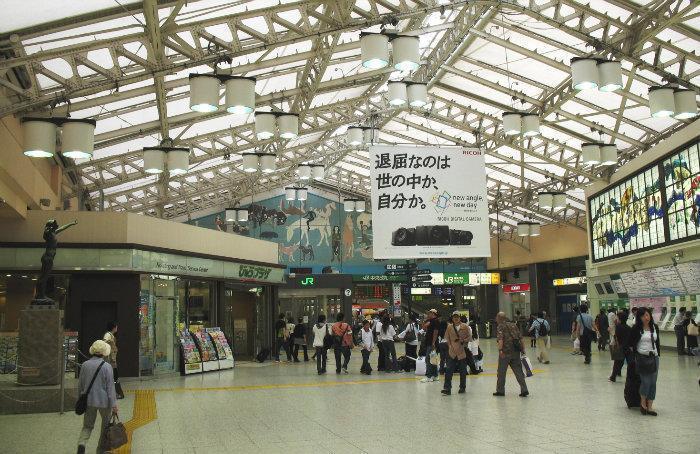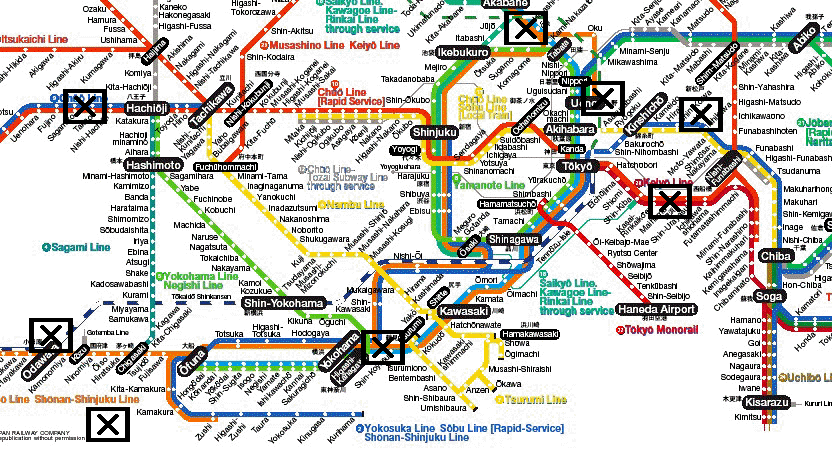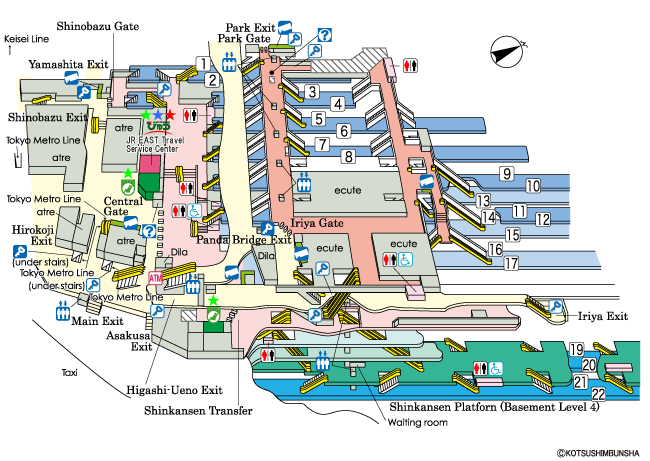Ueno Station
- Through station ( Ueno )
- Head station ( Keisei Ueno )
- 21 (JR East)
- 04 ( Tokyo Metro)
- 04 ( Keisei Dentetsu )
JR East:
- Joban Line
- Keihin - Tohoku Line
- Takasaki Line
- Utsunomiya Line
- Yamanote Line
JR East Shinkansen:
- Akita Shinkansen
- Joetsu Shinkansen
- Nagano Shinkansen
- Tōhoku Shinkansen
- Yamagata Shinkansen
Tokyo Metro:
- Ginza Line
- Hibiya Line
Keisei Dentetsu:
- Keisei Main Line
I7i12i13i15i16i16i18i19
The Ueno Station (Jap.上 野 駅, Ueno -eki ) is located in Taitō located in Tokyo and is the main junction for connections from Tokyo to the north, including several JR Higashi- Nihon (JR East) Shinkansen lines.
In Ueno ended in the past, most long-haul routes from the north of Japan, however, many compounds were first to Ueno and eventually extended to Tokyo and these tasks were increasingly declined since the introduction of the Shinkansen. In Keisei Ueno Station is not far away (京 成 上 野 駅, Keisei Ueno -eki ) Keisei Dentetsu ends the Keisei Main Line to Tokyo Narita Airport.
On -web spiders of the Tokyo Metro station with the registration G - 16 on the Ginza Line and H -17 is referred to on the Hibiya line.
- 2.1 Ueno Station
- 2.2 Keisei Ueno
History
Ueno Station
On 28 July 1883 the Ueno station as a passenger station of the private Nippon tetsudō as the starting point of the Ueno Nakasendō tetsudō after Kumagaya, now part of the Takasaki Line, opened. Some years later, in November 1890 also the freight operation, mainly, recorded for goods from Akihabara. 1906, the station was nationalized and transferred to the State Railway ( Kokutetsu ). On December 16, 1909 for the first time holding a train of the Yamanote line at the station. The original station building was large fires victim, which were caused by the Great Kanto Earthquake of September 1, 1923. The building burned down completely and only nine years later, the still existing new station building was officially opened on April 3, 1932.
However, between the destruction of the old and opening of the new station building there were some technical innovations with impact on the station. Thus, on March 1, 1925, the first building construction route of Japan, a section between Ueno and Tokyo, inaugurated and handed over to the passenger. Two years later, is dedicated to the first subway line in Asia on December 30, 1927. This is the track from Ueno to Asakusa which today forms part of the Tokyo Metro Ginza Line. On March 28, 1961 also holds the Hibiya Line of Tokyo Metro for the first time at the station.
After the Second World War, flourished in the area south of the railway station in the black market, since this is still the central transportation hub in the north of Tokyo.
In 1977 the decision was made to expand the station to the Shinkansen station. The first was the Tōhoku Shinkansen which on March 14, 1985 for the first time at the station Ueno made a stop and ended up here, in the subsequent period also ended all other Shinkansen here. He thus broke the previous railhead Ōmiya by the route extension from the selfsame. This status as a railway terminal Ueno held until 1990. On June 20th of this year, the Shinkansen line was extended to Tokyo Station and this has since then acted as a terminus.
In 1997, the railway station in the selection of the 100 stations in the Kanto region (関東 の 駅 百 選, Kantō no eki Hyakusen ) was taken of the Ministry of Transport.
Keisei Ueno
A little over a year after the opening of the new railway station building opened the Keisei Dentetsu in the west of the Station, the Ueno Park in the subsoil thereof at December 30, 1933 its own underground station Ueno Park Station (上 野 公园 駅, Ueno eki kōen ). This was originally designed for trains with a maximum length of four cars.
At the end of the Second World War, the Ministry of Transport took over on June 10, 1945 the station and gave it to start again on October 1, 1945 back following the surrender of Japan.
On 1 May 1953, the station received its present name as Keisei Ueno Station (京 成 上 野 駅, Keisei Ueno eki ). As was the Keisei Dentetsu 1967 trains with 6 cars started but the station is not designed for trains of this length, some trains had to end in the tunnel already at the previous station Nippori before entering. ( Which was later extended to Narita Airport ) Only after a renovation and the start of the new line Skyliner on October 25, 1972 could retract trains a length of 6 cars. Shortly afterwards, the railway station on 16 June 1973, closed for a period of exactly six months to make extensive renovations again. During this time, all trains ended at Nippori station before the station was scheduled to open again on 16 December 1973. With a further renovation in 1976, the station was given its present form, allowing the entrance of trains with 10 wagons.
Design and tracks
The railway stations of all three companies are to ensure through underground tunnels and overhead pedestrian bridges linked together to a smooth transfer between lines of the various operators.
Ueno Station
The Ueno station was built in the commonly encountered form of a train station as a transit station. The station hall is located on the ground floor, the tracks of the Shinkansen in the underground, the tracks of the other lines on a high line and in a further ground plane between the hall and the Shinkansenebene below. All 21 platform tracks of the JR East run in a north-south direction but at different levels. The track entrances are located on the concourse level to earth and in the plane above the building line with the tracks 1 to 12
The tracks 1 to 12 together form six central platforms that are served by the Joban Line, Keihin - Tohoku Line, Takasaki Line, Utsunomiya Line and the Yamanote Line.
The second complex form the rails 13 which extend to 17 in the first underground level, track 13 forms a side, the tracks 14 to 17 two central platforms. These are approached on the tracks 13 to 15 of the Takasaki Line and Utsunomiya Line, the tracks 13 and 16 and 17 are served by various special and express trains. These include the Hokutosei, Cassiopeia, Akebono, Hokuriku, Minakami, Kusatsu, Akagi, Noto and the Super Hitachi.
In a second underground level, all tracks of the Shinkansen lines run these are numbered with the track numbers 19 to 22 and are distributed on two central platforms. Track 19 and 20 are thereby served by trains coming from Tokyo, 21 track for trains to Tokyo. Track 22 is only used at peak times as an additional track to Tokyo.
What is remarkable is the numbering of the platforms that there is no platform with the number 18 more today.
The Tokyo Metro station is also built as a through station for the Ginza and Hibiya line is completely underground at the station square and can be achieved by separate entrances to the surrounding streets and the entrance hall of the JR station. The platform accesses are located on the first underground level, the tracks in a second underground level. The platforms of both lines run from southwest to northeast, but are about 60 feet apart, a direct transfer is not due to lack of connections to the access control to the tracks possible. When the platforms of both lines are side platforms and are each numbered 1 and 2.
Keisei Ueno
The Keisei Ueno station was built as a terminus station in the basement of Ueno Park. He has hit that two central platforms with a total of four tracks. The station is connected underground with connecting roads and overground via pedestrian bridges to the Ueno Station on the JR East and Tokyo Metro. All trains have sailed out of the station the Keisei Main Line, however, are according to their retention at the stations along the route named differently.
Lines
The Ueno Station is served by several lines of the Tokyo Metro and JR East. In addition, the station is also maintenance of all Shinkansen lines in the north and several express and special lines of JR East. The Keisei Ueno Station is the starting point for trains Keisei Main Line.
Environment
→ Main article: Ueno (Tokyo)
The area around the station is dominated by the Ueno Park just west adjoins the Ueno Station or Keisei Ueno station was built directly under him. Through its many cherry trees in the park as the annual meeting place for Hanami is very popular. But also the rest of the year attractions including a statue of Saigo Takamori and the National Museum of Western Art, the Tokyo National Museum, the Art and Music Academy Tokyo National University of Fine Arts and Music and other cultural institutions. In addition, also located in the park of the Ueno Zoo.
South of the railway station, the area in which after the Second World War, the black market was operated, developed into a popular shopping and entertainment district.
The Tokyo Metro has its headquarters near the train station.
Shops near the train station
Input Ueno Zoo
Headquarters of Tokyo Metro
Use
In 2008, the station from an average of 181 244 passengers was used on the day, so that the rank 13 took over 900 on the ranking of the busiest train stations of JR East in 2008. The lines of the Tokyo Metro were used by an average of 213 522 passengers per day in 2008. The train station is so number 8 in the busiest train stations of Tokyo Metro in 2008. Keisei Ueno Train Station Keisei Dentetsu was used in 2008 by 21,350 and 25,464 zusteigenden disembarking passengers each day on average. The station was so in 2008, 8th in the busiest train stations in society.









